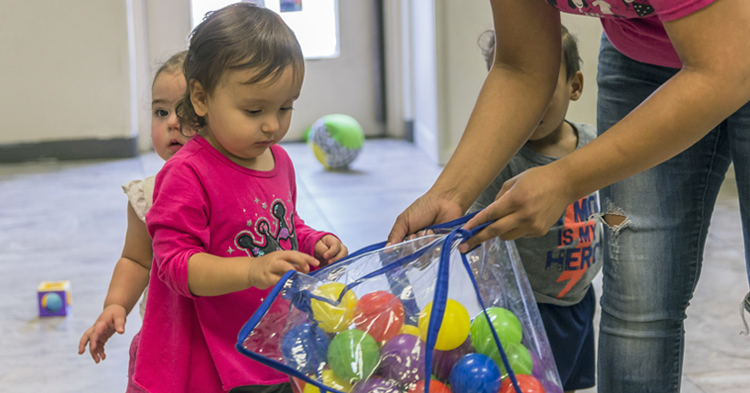How do you respond when parents ask: “Do the kids just play all day?”
If you’ve ever struggled to respond to this question, you’re not alone. There are many different ideas about how children should learn. How you communicate with families about your program and your quality early learning practices will benefit them in the present and even after they leave your care.
Here are some tips to consider about the written materials describing your educational philosophy, how you document children’s learning through play, and the words you use to communicate about a child’s experiences at your program.
Your Educational Philosophy and Written Materials
High quality early learning programs have written policies for sharing curriculum information with families. Before enrolling in your program, families should know about your curriculum and instructional methods.
Here are a few examples of ways curriculum can be shared with families:
- During a tour of your program, staff should point out how the classroom is set up to support children’s learning through activities.
- Parents are provided with a copy of a daily schedule and lesson plan. Lesson plans indicate the learning goals and objectives for planned activities.
- Parents are provided a written statement of the program’s educational philosophy, including the important role of learning through hands-on experiences.
You may find that you already do some or all of these practices to share information with families. However, are these practices identified in a written policy? Having a written policy about how you share this information with families ensures consistency in implementation between staff members and over time.
Documentation Panels
Often, the most rich and complex learning occurs through a process that doesn’t have an end product. For example, during outdoor play, children are making mud pies, altering the ratio of dirt to water to get just the right consistency to cut and serve pieces on play dishes.
As an educator, you note the development of social skills and the learning of math and science that takes place through this activity. Families don’t get to see these learning experiences and may be looking for something more tangible, like a piece of work in their child’s backpack. It’s up to you to share these observations with families.
Documentation panels will tell the story of a child’s education through photographs and written descriptions of experiences and play. Hanging these displays on the walls provides a natural conversation starter for families and prospective families, as well as showing children the value you place on them as learners. Click here to view a short video about how a teacher used this practice to document children’s learning about frogs. Review this article from NAEYC for even more things to consider when embarking on this practice.
Anecdotal Notes
Anecdotal notes are written descriptions of your observations of children’s learning. By collecting anecdotal notes while children play, you gather a clear picture of children’s development and gain a record of children’s skill development over time.
High-quality early learning programs set aside time to discuss children’s learning with families, such as through conferences. Sharing the anecdotal notes you have gathered over time allows families to see the development of their children’s skills through play-based activities. For example, you may choose to highlight a preschooler’s development in the area of emotional development by noting a child’s correct use of new emotion words during pretend play in the housekeeping center.
Word Choice
In addition, consider the language you use when talking about your teaching practices. As you talk with families about the events of the day, do you focus on the engagement of the children and their level of focus and attention during activities? Do you point out observations about new skills you observe children using as they play?
Often we naturally highlight the fun children are having, without also taking time to also highlight the learning that is taking place. Consider how you describe the physical environment with words like: play room, toys and games. These words connote play but do not specifically highlight learning. Consider adding words like: learning materials, investigation, exploration and learning activities. These descriptions will help parents understand all the learning that is going on with their child.
Communication Matters
How you communicate about your program matters. At Quality First, we recognize that young children learn best through real-life and play experiences.
How do you talk with families about children’s learning through play? What new practices have you added to enhance this element of your program and communication with families? We would love to hear from you, so please send us an email with your ideas and story to: QualityFirst@firstthingsfirst.org.
